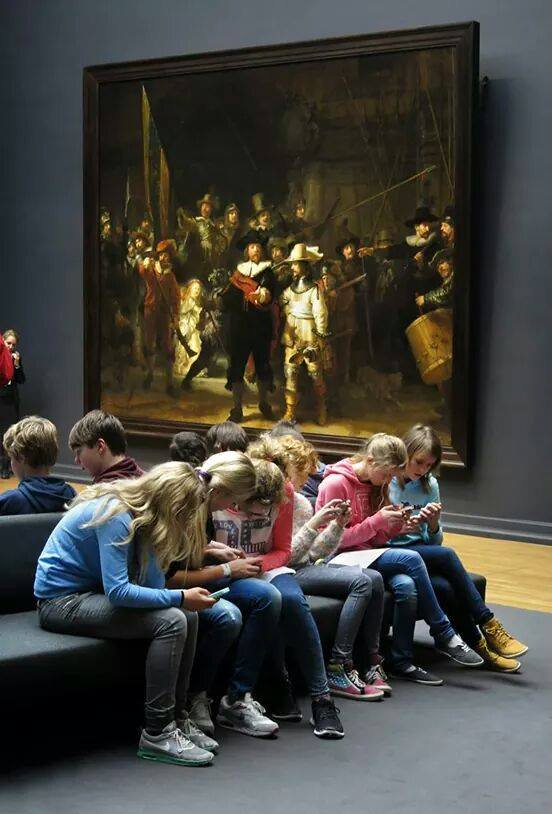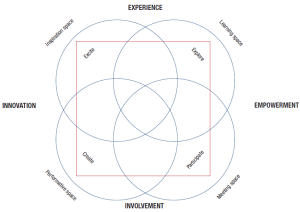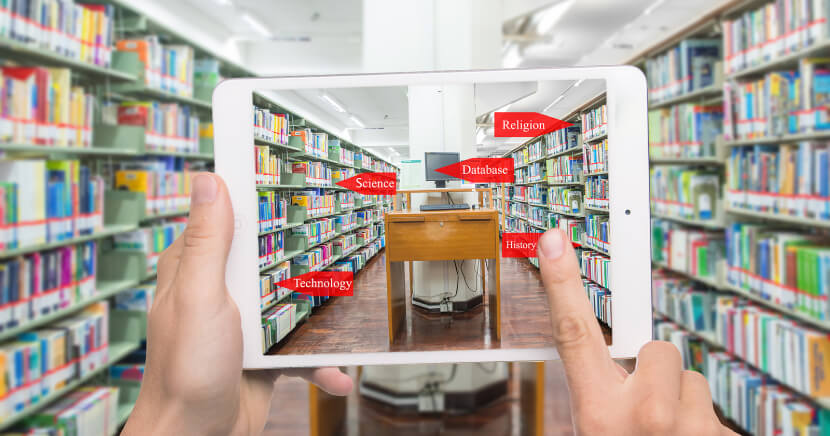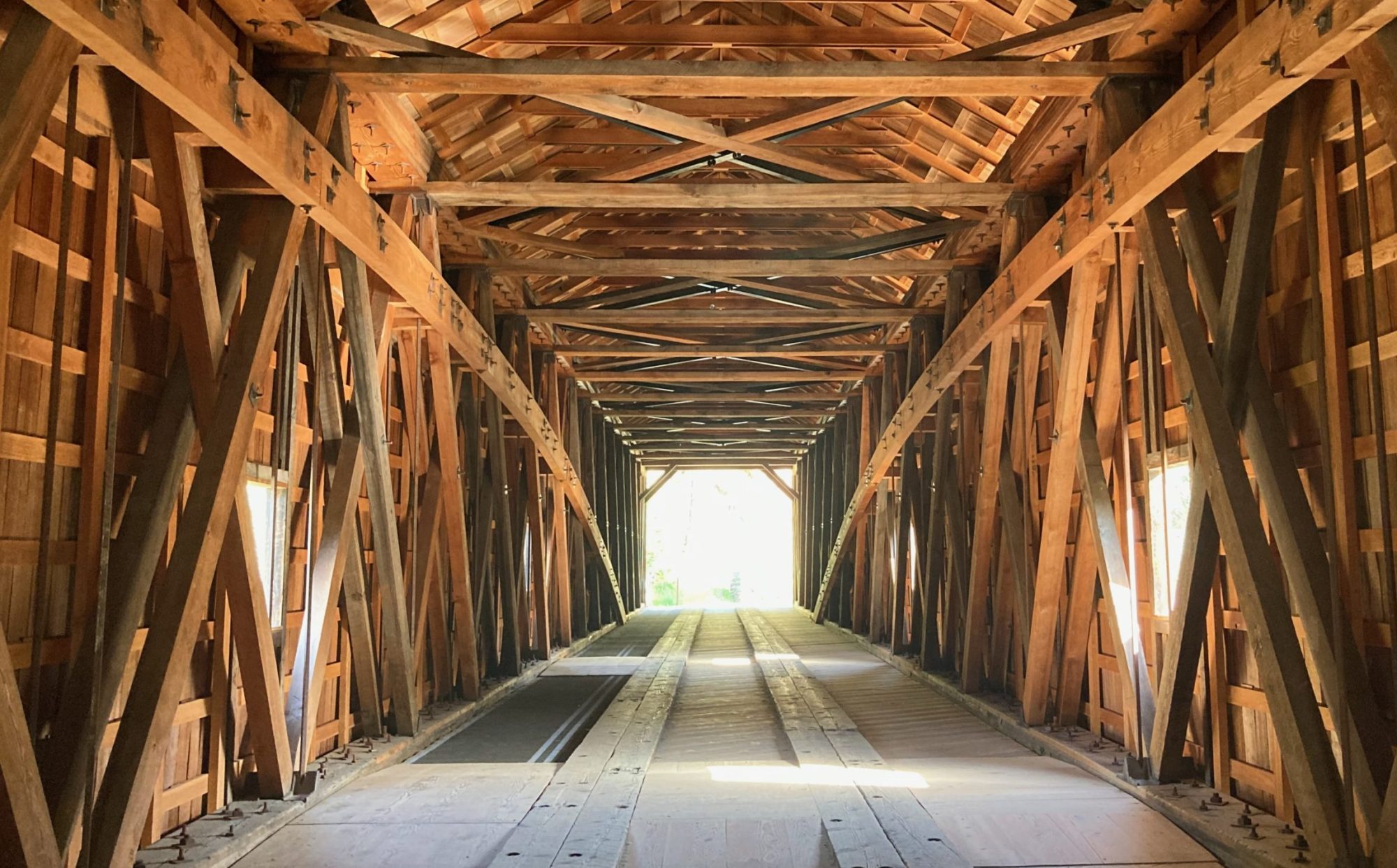“Any sufficiently advanced technology is indistinguishable from magic.”
– Arthur C. Clarke
The Oakland Musem of California’s exhibit Angela Davis – Seize the Time included an Augmented Reality (AR) option offered by Black Terminus AR, which allowed visitors to hold their phones up to select displays in the exhibit to access additional media and information – a poster of Angela might activate a video of her speaking, a photograph might come to life and show a news story on the event from that time. The experience enhanced the exhibit, allowing visitors to take in what was not just physically in the display, but also gave them an opportunity to immerse themselves in even more history and richness. It expanded the exhibit to include so much more than what could physically fit on the walls, or in the gallery space.

In Module 4’s lecture, @michael shared a photo of students at a museum, engrossed with their phones, and shared why it went viral, and why it should have gone viral for opposite reasons – these students were not scrolling their apps out of boredom or disinterest in the museum, but instead were learning more for an assignment through the use of the museum’s app that provided more in-depth information about the exhibits. Indeed, technology is everywhere, and it is no longer an add on – it is real and it can be embedded and integrated in ways that expand our sense of the world, and broadens the expanse of the spaces we visit.
A NEW DIMENSION
Now, what does this mean for libraries?
A future that is exciting with endless opportunities. (Though, let’s hope those working in the libraries are on board with this sentiment!)

Danish LIS-scientists Dorte Skot-Hansen, Henrik Jochumsen and Casper Hvenegaard Hansen’s 4-space model for designing libraries proposes overlapping spaces for inspiration, meeting, learning, and performing. The hyperlinked library could contribute another dimension – an AR space that could add depth and accessibility to all four of the library spaces, creating an integrative richness that elevates and adds a new level of information services to any library’s physical structure and contents.
THE POSSIBILITIES ARE ENDLESS!
What could this look like?

Some libraries are already utilizing AR:
- Enhancing library exhibits like the National Medical Library, giving access to special collections that might otherwise be less readily accessible.
- Creating virtual library tours like UC San Diego, allowing students and visitors to preview and familiarize themselves with the library, floor by floor.
- Creating virtual storytelling experiences like the National Library of Korea’s use of AR to create interactive book displays.
In comparison to Virtual Reality, Augmented Reality can be integrated into libraries with less financial commitment and technological equipment, as it can be an element that can be accessed through patrons’ individual devices (or devices that libraries might be able to more affordably offer for loan), opening up a new dimension to physical spaces.
Imagine being able to hold up a copy of a book you enjoyed to your device, and being able to instantly pull up read-alike books, see what’s available in the library, and where to find it. Or viewing a physical book display and using your device to access an AR version that includes links to author information, first chapter preview videos or book read-alouds, book reviews by fellow patrons, or related articles or news. Lib guides could be integrated in the physical library space according to the section you might be visiting – scan the call number of a book on your topic and access further related resources and bibliographies. AR-enhanced announcements for upcoming events could show presenter information, a link to add it to your calendar, related books or news. The patron can now be immersed in information at their choosing, without losing access to the physical options still residing in the library.
KNOWLEDGE SHARING & ENGAGEMENT
Some naysayers may argue that Augmented Reality (AR) could never replace an in-person conversation with a reference librarian, and I would agree – this technology wouldn’t replace librarians; it would enhance the possibilities, their offerings, and the extent of their reach. Reference librarians are fountains of knowledge! Imagine taking that knowledge and widely disseminating it in an AR format to be placed at the convenience of patrons browsing casually in the stacks, or even browsing the library website from home. Imagine librarians from libraries the world over sharing their knowledge in this AR dimension so that a patron in South Carolina could find a recommended reading list compiled by a librarian across the country in Oregon. Maybe that patron then reaches out to the contributing librarian and starts an in-depth conversation about the topic of that reading list and from there connects to others who share similar interests. Collective knowledge as collective power!
This is to say nothing of the possibilities that exist to engage the library community itself in creating their own AR contributions. If patrons can write shelf-talkers for books they loved on note cards in the library, imagine what they might be able to create in AR given the opportunity and skills to do so – audio/visual book reviews by fellow readers and the chance to get to know fellow patrons all in one! There are countless ways that AR can engage not only teams of librarians on staff, but teams of patrons from the community both locally and beyond.
ACCESSIBILITY 2.0
Libraries operate in limited physical spaces with limited physical collections and limited physical staff. Adding the element of AR would allow patrons to more easily engage with physical reality by means of the augmented reality – whether it provides access to audio descriptions of visual objects (or vice versa), activates relevant information that can more easily be translated to a patron’s native language, or allows a mobility-restricted patron the opportunity to freely explore a library exhibit previously unaccessible. There are opportunities in Augmented Reality for thoughtful, accessible creations that increase library user access not just to the materials physically available, but also giving greater access to otherwise limitedly accessible materials, such a special collections, event recordings, and time-restricted materials preserved in archives. In a 2015 presentation to the Rare Book School, Sarah Werner outlined how to use social media to destroy special collections – there’s no reason libraries now can’t destroy their library walls, shelves, and displays with AR.
LEANING IN, LEVELING UP, AND OTHER CONSIDERATIONS
New technology and new applications will unsurprising be accompanied by as much anxiety and fear as excitement and inspiration. Fortunately, it’s already happening, which means there are existing leads to follow, examples to cite, and a place from which to start ideating further. Some considerations as we venture into this fifth dimension:
Experiment & Play: In Matthews’ white paper Think Like a Startup (2012), innovation is emphasized, with the notes that innovation is messy: “It takes many wild ideas that flop in order to find transformative gold.” As librarians begin to play (yes, play!!) with how AR expands their library spaces, I hope they are able to do so with the encouragement to play freely, experiment wildly, and bravely embrace big ideas and possibilities.
Privacy Protection: When venturing into new technology, users and providers alike will have concerns about privacy, which should, as always in library spaces, be protected. There may be opportunities where AR allows for people to connect personally if creators so choose to share their identity/contact information, but clear protections of user privacy will ensure that patrons will feel more comfortable with their explorations.
Evaluation & Iteration: As with any new implementation, there is value in taking assessment of how the patrons are engaging and enjoying having a new element in their library experience. Getting feedback from patrons, utilizing any data analytics available to assess usage, and hearing stories will allow libraries to determine where to best make further developments, eliminate areas that aren’t suited to patron needs, or make modifications to what has been implemented.
BON VOYAGE!
Libraries everywhere often face the challenges of wanting to provide more for their patrons in the face of limitations with updating or expanding physical spaces. AR provides the opportunity for all libraries to add to their offerings by drawing forth a fifth dimension beyond what they can squeeze within four walls, and 4-spaces. It’s a journey that can broaden and expand libraries in infinite ways – bon voyage, fellow librarians! Enjoy the ride!
—
AFTERWORD
In reflecting on this assignment, one thing that I appreciated was how valuable it is to have designated time to explore a concept, discover what’s happening in the library world, and freely ideate, which is something I find can be lacking in the day-to-day operations of libraries and the work of librarians (and, well, everyone else in every other occupation). Often, librarians are on duty or assisting colleagues at service desks, working diligently away on operational projects, and checking off administrative tasks to keep the library operating optimally, which makes sense – that’s their job. For true growth and development though, it seems like it would be vital to include something like Google’s 20% Projects, which carves out space and time necessary for creative new ideas to take shape and grow into innovation.
I also recognize that not all librarians might be interested or receptive to diving into new technology, which can surely be the case for bringing onboard anything new. My hope is that the library culture is one that makes genuine effort to build the fifth dimension of library services with transparency and a deep inspiration for collaboration that fosters collective enthusiasm.
effort to build the fifth dimension of library services with transparency and a deep inspiration for collaboration that fosters collective enthusiasm.
—
TRY IT OUT!
Download the Black Terminus AR App and focus your AR cam on the book cover image to the right to see it at work.
Start creating your own AR!
—
REFERENCES:
Abram, S. (2019, January 22). Augmented reality in libraries: Technology trends that aren’t “out-there” anymore. Lucidea. https://lucidea.com/blog/augmented-reality-in-libraries-technology-trends-that-arent-out-there-anymore/
Black Terminus AR. (2024). https://www.blackterminus.com/
Laerkes, J.G. (2016, March 29). The four spaces of the public library. International Federation of Library Associations and Institutions: IFLA Public Libraries Section Blog. https://blogs.ifla.org/public-libraries/2016/03/29/the-four-spaces-of-the-public-library/
Matthews, B. Think like a startup. vtechworks.lib.vt.edu
National Library of Medicine. (2002). Dream anatomy. https://www.nlm.nih.gov/exhibition/dream-anatomy/index.html
Oakland Museum of California. (2022). Angela Davis – Seize the time. Oakland Museum of California. https://museumca.org/on-view/angela-davis-seize-the-time/
Plug XR. (2023, July 5). Augmented reality in libraries. Medium. https://medium.com/end-to-end-ar-solution/augmented-reality-in-libraries-revolutionizing-the-way-we-learn-2af9d898b315
Pressreader Team. (2023, December 11). A new dimension: Augmented reality in libraries. Pressreader. https://blog.pressreader.com/libraries-institutions/a-new-dimension-augmented-reality-in-libraries
Theatretrain HQ. (2024, April 26). Unleashing creativity with Google’s “20% Project”: A model for innovation and structured freedom. Theatretrain. https://theatretrain.co.uk/unleashing-creativity-with-googles-20-project-a-model-for-innovation-and-structured-freedom/
UC San Diego. (2024). Virtual Library Tour. https://library.ucsd.edu/visit/library-tours/virtual-library-tour.html
Werner, S. (2015). How to destroy special collections with social media. https://sarahwerner.net/blog/2015/07/how-to-destroy-special-collections-with-social-media/
